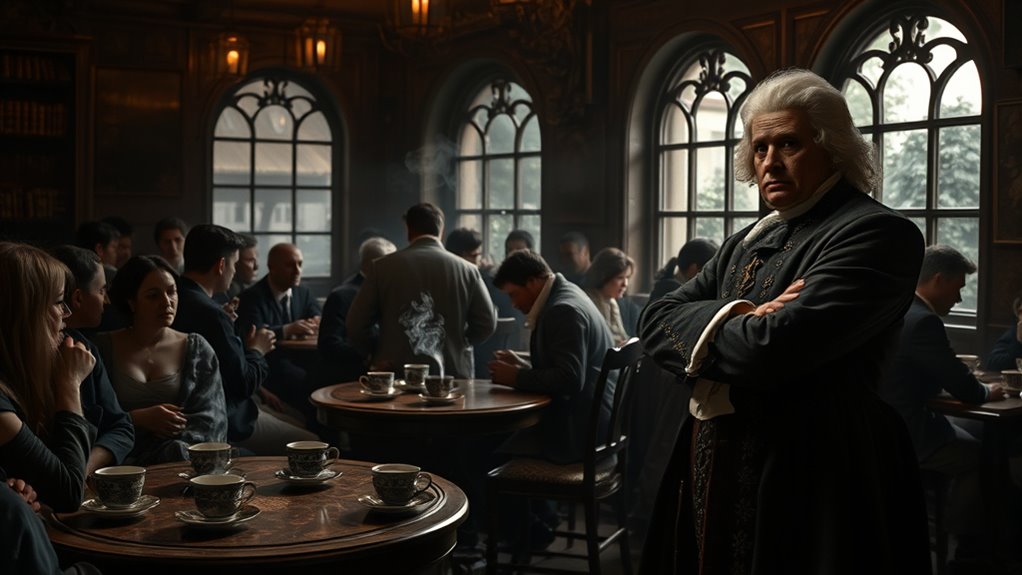Coffee was once banned in Europe due to its association with social unrest. Clergy condemned it as satanic, fearing its stimulating effects could lead to disorder. Political leaders echoed these concerns, imposing bans to maintain control. However, coffeehouses emerged as centers of dissent, fostering revolutionary ideas. Resistance movements formed underground networks to continue the coffee trade, proving that bans couldn’t suppress this beverage’s influence. There’s much more to discover about coffee’s impact on European culture.
Key Takeaways
- Coffee was initially condemned by clergy who viewed its stimulating effects as a threat to social order and morality.
- Political leaders, fearing coffeehouses promoted dissent, issued bans to suppress what they saw as revolutionary gatherings.
- Sultan Murad IV enforced strict penalties against coffee consumption, reflecting concerns about its impact on society.
- King Gustav III of Sweden attempted to ban coffee in 1746, even conducting experiments to demonstrate its supposed dangers.
- The underground coffee trade emerged as a form of resistance, showcasing community resilience against prohibitive measures and societal control.
The Rise of Coffee in Europe
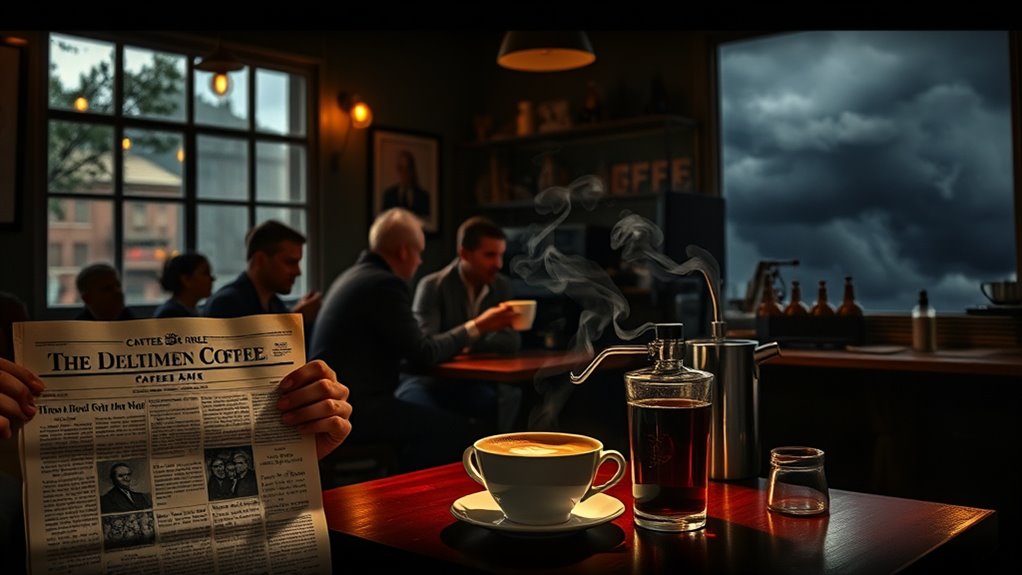
As coffee began its journey into Europe in the 16th century, it quickly captivated the elite and literate classes, transforming the drinking culture of the time.
Initially, clergy condemned drinking coffee, calling it satanic, but Pope Clement VIII’s endorsement changed everything. His approval helped normalize coffee, and soon, coffeehouses sprouted across cities like London and Paris.
Clergy once labeled coffee satanic, but Pope Clement VIII’s endorsement spurred its rise, leading to the flourishing of coffeehouses across Europe.
These establishments became social hubs, fostering conversations, political debates, and intellectual exchange, challenging traditional customs that revolved around alcoholic beverages.
The rise of coffee marked a pivotal shift in social customs, moving away from wine and beer toward this invigorating brew. By the late 1600s, coffee became a staple in Europe, redefining how people interacted and socialized in public spaces. Additionally, the ambiance of these coffeehouses often featured rustic lighting, creating a warm and inviting atmosphere that encouraged patrons to linger and engage with one another.
Religious Opposition to Coffee
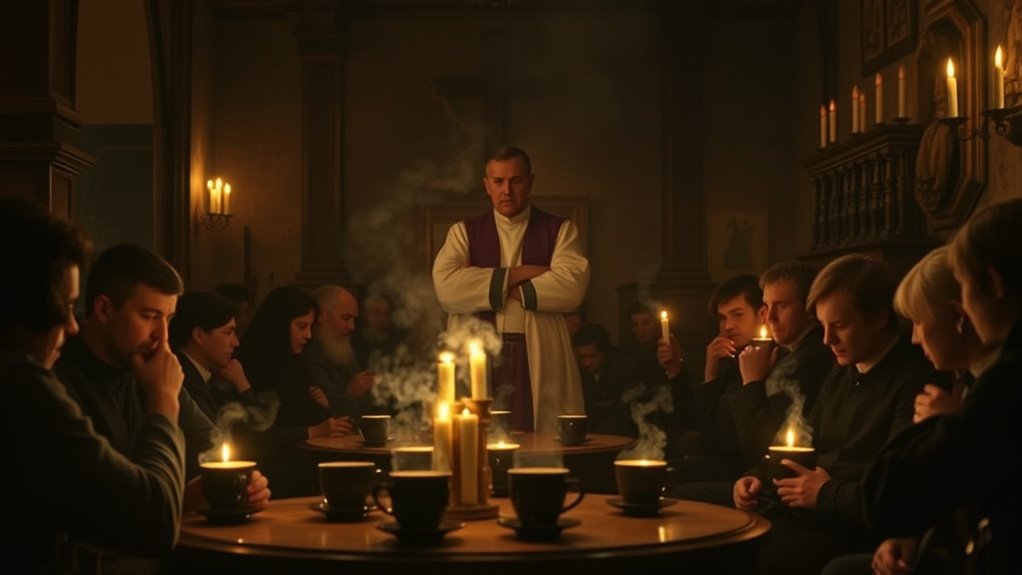
Despite its growing popularity, coffee faced significant opposition from religious authorities in Europe.
Clergy labeled it a satanic drink, fearing its stimulating effects could spark radical thoughts and lead to social disorder. This fear fueled calls to ban coffee across various regions.
- Coffeehouses buzzing with lively discussions.
- Clergy condemning the drink in fervent sermons.
- Pope Clement VIII savoring coffee and declaring it delicious.
Fortunately, Pope Clement VIII’s endorsement helped shift the negative perception, allowing coffee to be embraced as a Christian beverage.
His support contributed to the rise of coffeehouses as social hubs, enabling intellectual exchange and political debate, which ultimately transformed the landscape of European society.
Political Bans and Social Concerns
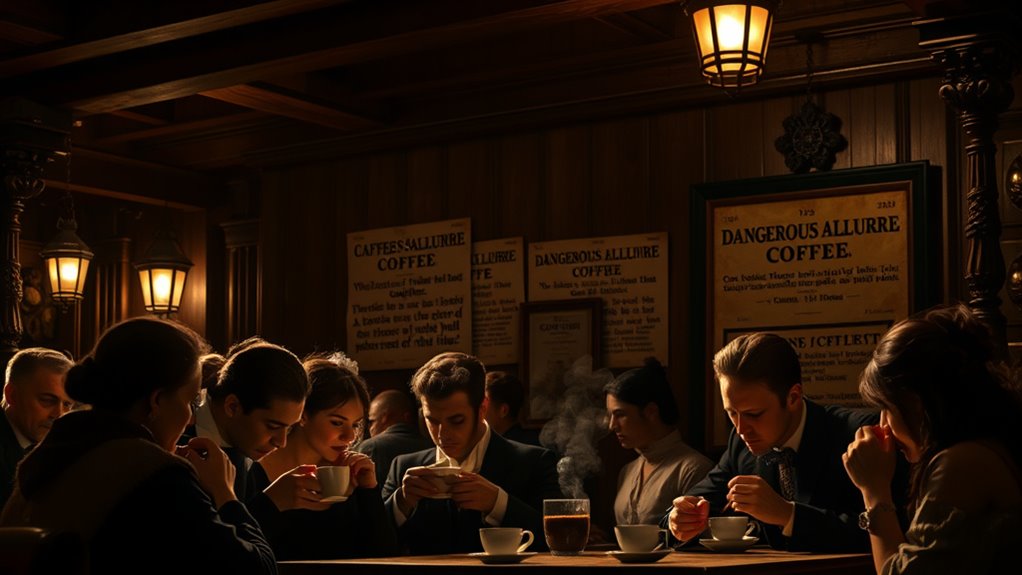
The rise of coffeehouses not only sparked intellectual debate but also drew the ire of political leaders who saw them as threats to social order. Concerns about coffee consumption led to various political bans. For instance, Sultan Murad IV imposed strict penalties in Constantinople, fearing coffeehouses spread radical ideas. Similarly, King Gustav III of Sweden banned coffee in 1746, even experimenting on death row inmates to gauge its health effects. Frederick the Great of Prussia promoted beer over coffee in 1777, arguing coffee interfered with lower-class drinking habits.
| Political Figure | Action Taken |
|---|---|
| Murad IV | Banned coffee consumption |
| King Gustav III | Banned coffee and paraphernalia |
| Frederick the Great | Promoted beer over coffee |
| Various Leaders | Enforced coffee bans |
Coffeehouses as Hotbeds of Dissent
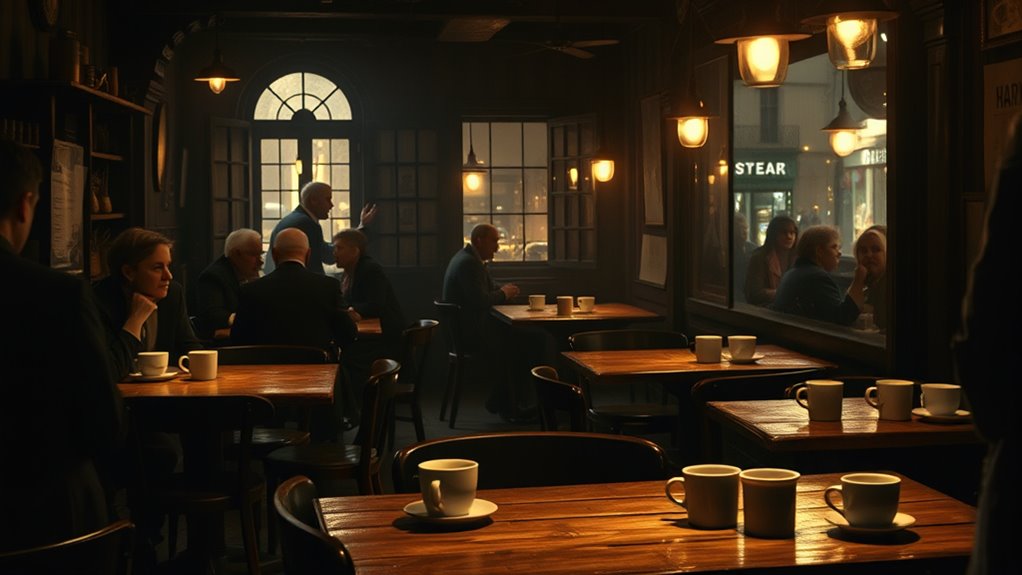
While some viewed coffeehouses as mere places to enjoy a drink, they quickly transformed into vibrant centers of dissent and debate.
These venues buzzed with energy, fostering revolutionary ideas and challenging authority.
Picture:
- Gatherings of thinkers passionately discussing Enlightenment ideas, pushing boundaries of thought.
- Penny universities where patrons engaged in political debates, igniting the flames of dissent against oppressive regimes.
- Echoes of laughter and whispers that masked radical ideas, unsettling figures like Murad IV, who banned coffee in the Ottoman Empire fearing corruption.
As coffeehouses proliferated in 17th-century Europe, they became hotbeds for dissent, nurturing a culture where radical thoughts could thrive, ultimately reshaping society’s political landscape.
Underground Coffee Trade and Resistance
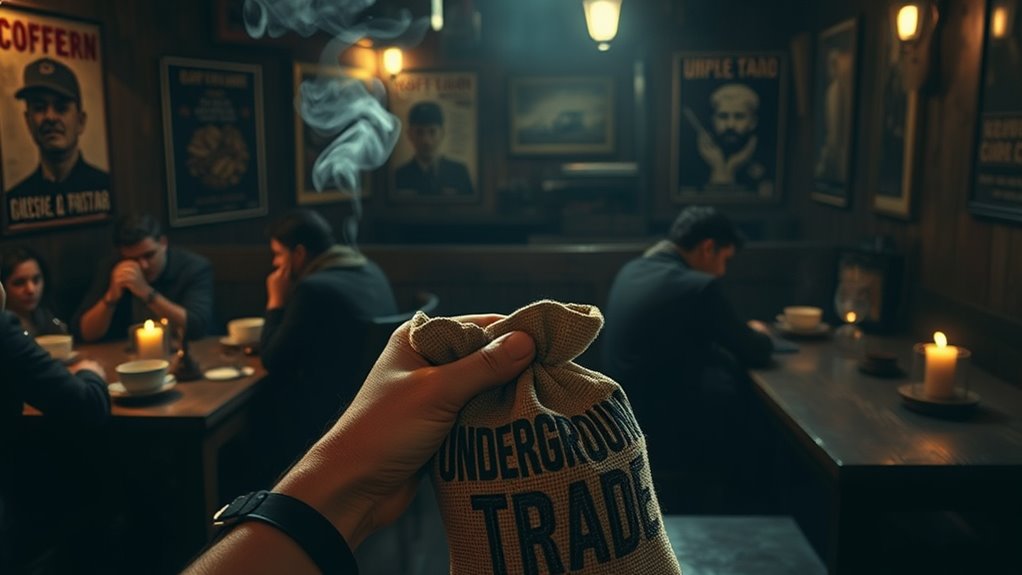
As coffee bans tightened in Europe, you’d find women stepping into the shadows, risking everything to keep the beloved brew flowing.
They organized smuggling networks, driven by the need to support their families and resist oppressive laws.
This underground trade not only challenged prohibitions but also highlighted the economic struggles many faced during that era.
Women in Illegal Trade
In an era when coffee was outlawed in Sweden, women like Maria Kiempe turned to the underground trade, not just out of defiance but as an essential means to survive.
These remarkable women embraced the illegal trade, maneuvering the risks of coffee bans to support their families.
Picture them:
- Steaming pots of illicit coffee brewing in hidden kitchens.
- A bustling black market where whispered exchanges happen under the cover of darkness.
- Women skillfully preparing coffee, showcasing their resilience and adaptability in domestic labor roles.
Often from lower socioeconomic backgrounds, these women transformed coffee preparation into a critical strategy for economic survival, defying social norms and asserting their place in a world that sought to silence them.
Coffee Smuggling Networks
Even though coffee was banned, demand for the beverage surged, leading to the establishment of intricate smuggling networks across Europe.
The underground trade flourished as economic necessity drove many, particularly women, to engage in illegal coffee trade. Government bans aimed at reducing luxury imports only intensified the allure of coffee consumption among the populace.
Fines for selling or drinking coffee could equate to months of labor for unskilled workers, highlighting the risks involved in this coffee smuggling. Women like Maria Kiempe became key players in this illicit market, often motivated by dire financial situations.
Statistical studies revealed that lower social classes consumed coffee more than assumed, challenging the perception of who participated in the underground coffee trade during prohibition.
Resistance Against Prohibition
Despite the government’s attempts to quash coffee consumption through strict bans, a vibrant underground coffee trade emerged, driven by the insatiable demand of the populace. The illegal coffee trade flourished as people sought out their beloved brew, showcasing their resilience against prohibition.
- Women like Maria Kiempe became key players, utilizing their resourcefulness for economic survival.
- Offenders faced substantial fines, equating to months of labor, but the allure of coffee was too strong.
- Organized coffee smuggling networks developed, proving the lengths individuals would go to for their daily fix.
This intersection of gender and trade highlighted not just a love for coffee, but a community’s determination to defy restrictions and maintain access to the cherished drink amidst strict coffee bans.
Lasting Impact of Coffee Bans on Culture
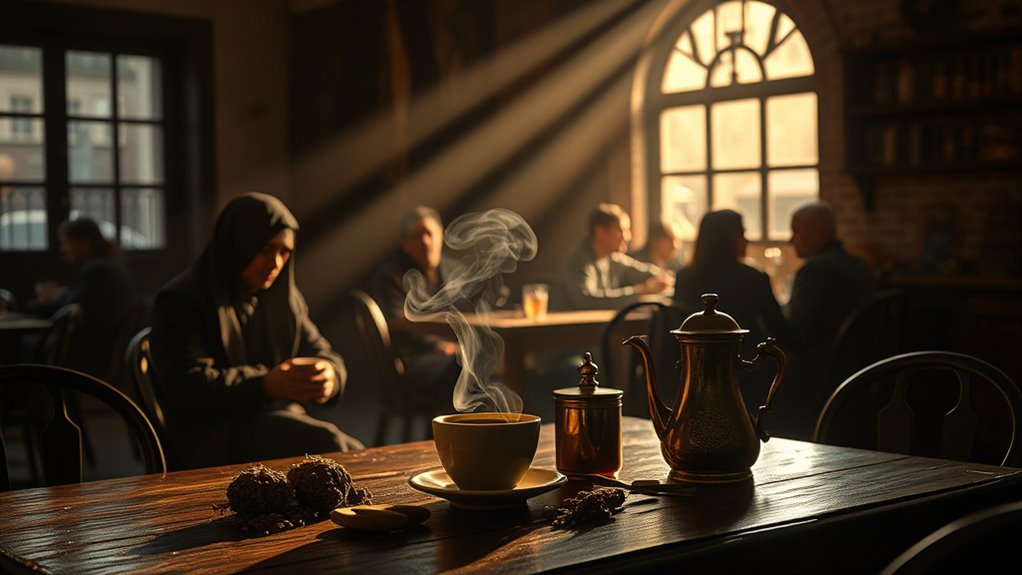
While coffee bans may have aimed to control social order and health, they often backfired, igniting vibrant underground cultures.
In history, countries like the Ottoman Empire and Sweden attempted to ban coffee, fearing its influence on radical thought and community dynamics. Instead of quelling consumption of coffee, these bans led to the rise of coffeehouses, which became social hubs for intellectual and political debates during the Enlightenment.
Frederick the Great’s 1777 manifesto promoting beer over coffee further underscored cultural tensions surrounding beverage preferences.
Ultimately, these attempts at prohibition not only shaped attitudes toward coffee but also fostered resilience, creativity, and connection among those who cherished this once-demonized drink, leaving a lasting impact on culture.
Frequently Asked Questions
Why Was Coffee Banned in Earlier Times?
Coffee was banned in earlier times mainly due to fears about its effects on society. Authorities believed it fueled radical ideas and social gatherings, which threatened their control.
Religious leaders labeled it as sinful, while rulers worried that coffeehouses might promote dissent and disorder. Some even conducted bizarre experiments to determine its health effects.
Ultimately, these bans stemmed from a desire to maintain order and suppress any challenges to established norms.
Why Was Coffee so Controversial When It Came to Europe?
Did you know that by the 17th century, Europe had over 3,000 coffeehouses?
Coffee sparked controversy because it became a hub for political discussion and dissent. Authorities feared these spaces encouraged radical ideas and social unrest. Clergy labeled it as satanic, while rulers like Sultan Murad IV imposed harsh penalties for its consumption.
The drink’s popularity clashed with traditional values, prompting bans and debates over its potential influence on society.
Why Was Drinking Coffee Punishable by Death?
Drinking coffee was punishable by death due to its association with social disorder and radical thought.
Authorities feared that coffeehouses fostered rebellious ideas and gatherings, undermining their power. In some regions, rulers imposed severe penalties, like execution or torture, to discourage consumption.
The extreme measures reflected a broader concern about maintaining control over society, as coffee became a symbol of unrest and potential upheaval.
You can see how such fears led to drastic actions.
Was Coffee Once Illegal?
Yes, coffee was once illegal in various places due to its controversial reputation.
In certain regions, authorities viewed it as a threat to social order or morality, prompting bans and harsh penalties for its consumption. For instance, King Gustav III of Sweden prohibited coffee in the 18th century, while the Ottoman Empire also sought to suppress it.
Despite these efforts, coffee eventually gained popularity and acceptance across Europe and beyond.
Conclusion
To sum up, while some might argue that coffee bans were merely a historical blip, they actually highlight the beverage’s role in shaping culture and society. By challenging authority and fostering new ideas, coffee became more than just a drink; it sparked revolutions and social change. So, the next time you sip your espresso, remember that you’re partaking in a rich legacy of defiance and creativity that has influenced Europe and beyond for centuries.
